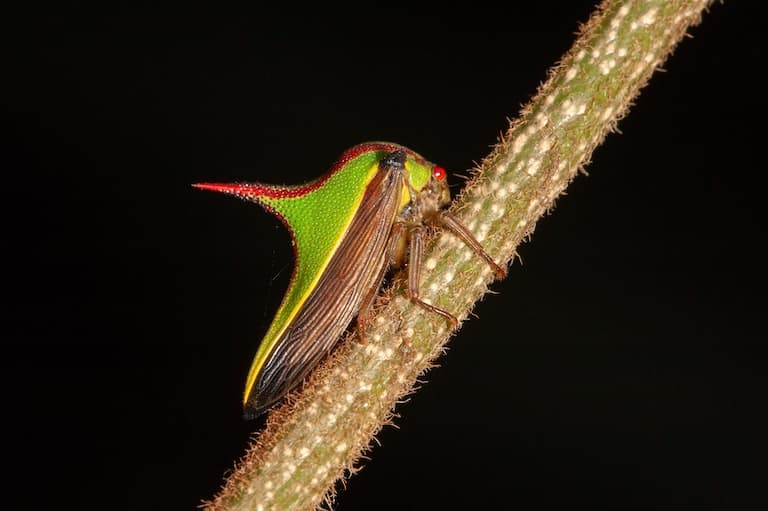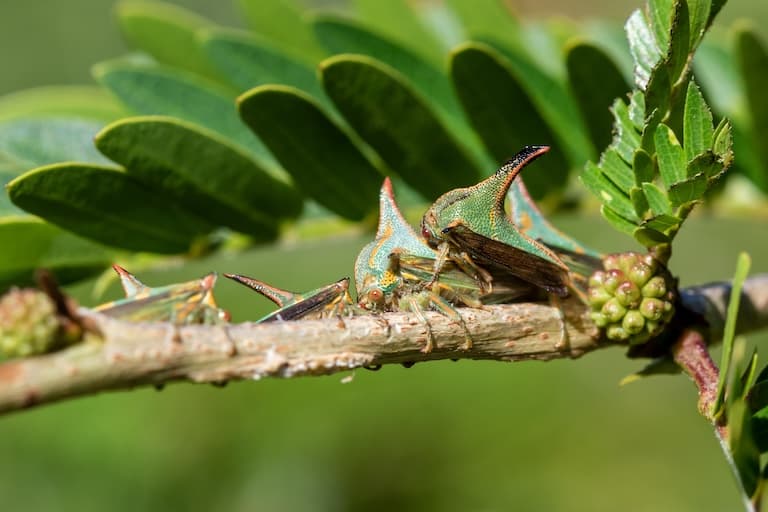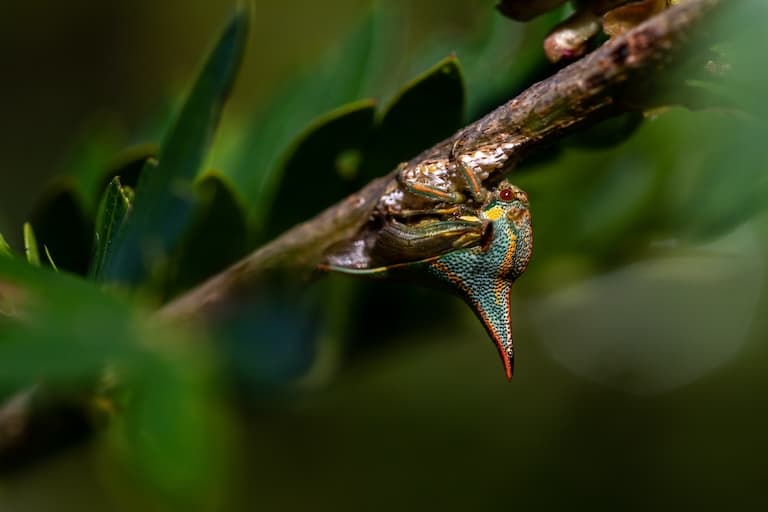Thorn Bug Profile
The inner world of bugs is one that’s often entirely overlooked, in part because the documentary hardware has only just become good enough to capture it, but also because, for many, arthropods appear entirely automated—a mindless, robotic contributor to the ecosystems that support more complex and, therefore, respectable life.
But animals like the thorn bugs show us there’s a lot more that’s relatable about arthropods if we could just look closely enough.

Thorn Bug Facts Overview
| Habitat: | Stems of ornamental and fruit trees |
| Location: | Mexico, Central America, and parts of South America ( |
| Lifespan: | Less than a year |
| Size: | Around 1.5 cm (0.6 in) long |
| Weight: | Unknown |
| Colour: | Green with red eyes and brown wings and legs |
| Diet: | Tree sap |
| Predators: | Mostly wasps and other bugs |
| Top Speed: | Slow |
| No. of Species: | 1 |
| Conservation Status: | Not Listed |
Thorn bugs are true bugs and a single member of the incredibly diverse family of treehoppers. They’re named for their protrusions, which, when gathered in their aggregations, give the impression of a stem thick with thorns.
They don’t move much and spend most of their time feeding slowly on their host plant, but this doesn’t mean they’re inactive—in fact, they have a very recognizable set of social behaviors, from the male’s dispersal to the female’s protection and even teaching behavior to her offspring.
Interesting Thorn Bug Facts
1. They’re treehoppers
Thorn bugs are part of an incredibly diverse family inside an incredibly diverse order of insects. While the beetle order Coleoptera is the largest, not far behind it are the true bugs of Hemiptera, these are defined by their role as suckers.
True bugs have piercing mouthparts that either suck up blood/body fluids or fluids from plants. Tree hoppers, thankfully, have picked the latter feeding strategy, and there are a lot of them! One family within the treehoppers, the Membracidae, makes up around 3,500 species in 40 genera.
One of those species is the thorn bug. Like all treehoppers, they suck fluids from their host plants, and like most of their family, they have impressive protrusions from their thoraxes.

2. They’re horny
Both males and females have a thickened, horn-like spine sticking out from their backs, but they appear quite different between the sexes and are easy enough to tell apart. Males are smaller overall with a blunter horn, and females look remarkably like the prickle of a rose.
But these horns vary quite a bit between individuals; sometimes they’re curved back, other times they’re more rounded, and so individuals are identifiable too.
Females are mostly green, and males can be a range of colors, usually from darker green than the females to almost black. 1
3. They’re warm-weather specialists
The native range of this species includes Central and parts of South America, and they have moved northward into Mexico and are recent arrivals to Florida, where it’s unclear if their presence is natural or a product of accidental introduction.
They are a potential pest species, but they are greatly restricted to warm climates, and if the temperature drops below freezing, they are unlikely to survive. A single sub-zero night can wipe out up to 90% of a population.

4. Fly-call-walk
These are quite social animals, and to spread their genes, it’s up to the males to disperse. Females mate only once, so males have strict competition to find and pair with one.
The process by which they do this is known as the ‘fly-call-walk’ strategy. There are three stages: flying from one plant to another; walking and signaling while on a plant; and a close-range courtship of encountered females.
The signalling this refers to is a curious one and involves vibrations generated by the muscles in the abdomen and manifests as a drawn-out tone with high-frequency clicks.
Males will mate several times, but females rarely mate more than once. After hatching, the offspring are then under the protection of the female until they’re old enough to disperse, and this vibration-based communication is critical to their survival. 2
5. Females are protective
These bugs are known for their parental care, and the new hatchlings are kept inside a crib made from scratched, spiral trenches in the plant’s bark. The adult female will ‘herd’ them to stay inside these scratches, where they’re safe from predators and can feed.
During this time, and from the moment her eggs are laid, she will defend them against other insects by attacking potential threats directly and responding to pheromone cues from injured nymphs.
This is something that is only just being discovered within true bugs—while pheromone responses have been described, this species is the first to show communication between adults and young.
But they communicate in more ways than this. 3
6. They communicate
Aggregations begin to disperse as the young reach sexual maturity. Before this, parents and nymphs are in direct contact through a vibrational communication system similar to that of the mating call.
The majority of communications relay threats from juveniles to adults, but it appears that there is also communication between the youngsters themselves.
There is a threshold of communication beyond which the mother will respond—if it’s just one fussy little youngster, she is unlikely to show up, but if they all make it clear they’re afraid, the mother will arrive to defend them.
If she arrives and can’t find the threat, she will “ask for help” and encourage more communication from the young, and if there is no threat to be found, she will release an “everything’s okay, quit your whining” vibration, which will reduce their sensitivity to fear as they age.
This last scenario happens when the kids get fussy for no reason and trigger a cascade of panic communications that need to be addressed. Over time, their responses become more refined and accurate at detecting danger. 4
7. They don’t live long
Despite the impressive complexity of these interactions, all of this life cycle happens in quite a short time. Four generations can arrive within a single year, and females will generally only lay one clutch in their lifetimes.
Adult males are sexually active for only a couple of months, and they appear to become less energetic as they age, but to compensate for this, there is a female preference for older males, perhaps as a way of reducing inbreeding within aggregations of her young.
The longer the female lives, however, the better the chances of her offspring.
Thorn Bug Fact-File Summary
Scientific Classification
| Kingdom: | Animalia |
| Phylum: | Arthropoda |
| Class: | Insecta |
| Order: | Hemiptera |
| Family: | Membracidae |
| Genus: | Umbonia |
| Species: | crassicornis |
Fact Sources & References
- Jeanine Velez-Gavilan (2022), “Umbonia crassicornis (thorn bug)”, Cabi Digital Library.
- Paul Anthony De Luca (2011), “The Influence of Age on Male Mate‐Searching Behaviour in Thornbug Treehoppers”, Research Gate.
- T. K. Wood (1976), “Alarm Behavior of Brooding Female Umbonia crassicornis (Homoptera: Membracidae)”, Research Gate.
- Jennifer A Hamel (2012), “Negative feedback from maternal signals reduces false alarms by collectively signalling offspring”, Pub Med.
